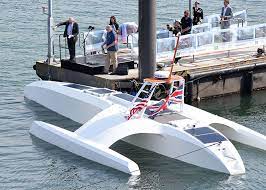Thanks to the pandemic, we missed out last year on the 400th anniversary of the voyage of the Mayflower from Plymouth, England to Plymouth, Massachusetts. The Mayflower left port in September 1620 and landed in what was to become Massachusetts in December of that year. But, better late than never, there’ll soon be a more modern Mayflower setting sail – well, sail may not be the right wording exactly – and this one will have zero humans on board. (Projected launch date: early June.)
The original Mayflower packed in 102 Pilgrims, plus 30 crew members, and the technology they had was pretty rudimentary. Astrolabe, quadrant, cross staff, compass. That and a primitive map were, at best, how the Mayflower made its way across the Atlantic. (I suspect that the Pilgrims were also praying their way to the New World while contending with terrible conditions: poor food, overcrowding, lack of water – they drank beer instead, seasickness, bad weather, cold, damp, foul air, rats, and, of course, the uncertainty about what they’d find when they reached the other side.)
In contrast to the thin technology available in 1620, the Mayflower Autonomous Ship (SA) is just packed to the gills with technology.
What’s on board this baby?
- 6 AI powered cameras

- 30 onboard Sensors
- 15 edge devices
And, as noted, no captain, no crew:
With no human captain or onboard crew, MAS uses the power of AI and automation to traverse the ocean in its quest for data and discovery.
The ship’s AI Captain performs a similar role to a human captain. Assimilating data from a number of sources, it constantly assesses its route, status and mission, and makes decisions about what to do next. Cameras and computer vision systems scan the horizon for hazards, and streams of meteorological data reveal potentially dangerous storms. Machine learning and automation software ensure that decisions are safe and in-line with collision regulations.
Small, lightweight edge devices provide just enough local compute power for the ship to operate independently, even without connectivity or remote control. When a connection becomes available, the systems sync with the cloud, enabling updates and data upload. (Source: MAS400.com)x
While this excursion is tied to a belated celebration of the four-hundredth anniversary of the original Mayflower, its purpose is scientific exploration. It will be gathering all sorts of data that will help researchers better understand what’s going on with the oceans. And, given the critical role that the oceans play when it comes to the earth’s climate, we can use all the data and understanding we can get. The information the Mayflower will gather, and the analyses this will enable, will also help improve navigation safety. And, of course, it will help bring us closer to the day when all modes of autonomous transportation – from cars, to trucks, to planes, to ships at sea – are deployed. (No, I’m not ignoring trains here. There are already autonomous trains in operation in a number of places, largely for rapid public transportation and freight hauling.)
The website for the Mayflower AS is well worth a look. Among other things, it lays out a scenario and details the sensory inputs, real time analytics, and outcomes for managing the scenario, based on the data and analysis.
I’ll be following the voyage of the Mayflower AS with interest, and wish them, as the sailors say, “fair winds and following seas.”
